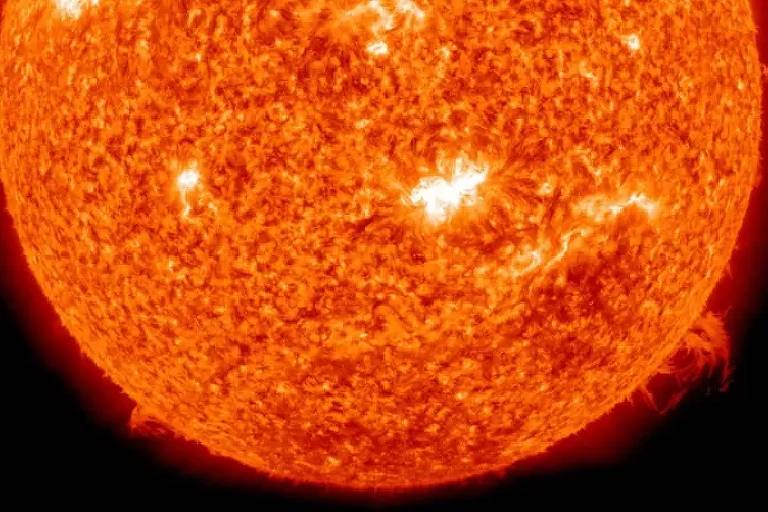Scientists have warned that a violent solar storm could disrupt communications on Earth and cause massive economic damage. Why are solar storms such a threat?
In 1972, dozens of sea mines mysteriously exploded off the coast of Vietnam – and it was recently confirmed that the explosions were caused by solar storms, which can greatly destabilize the Earth’s magnetic field.
Today, the effects of such an event could be even more dire, crippling the technology we use in everything from satellites to power grids. The economic cost of such an unexpected event in the UK alone has been estimated at £16 billion.
There are good reasons for our vulnerability to events millions of miles from Earth.
What causes a severe solar event?
The Sun is a star – a mass of boiling hydrogen charged with electricity. As this fluid moves, it accumulates energy in its complex magnetic field.
This magnetic energy is released by intense rays of light known as solar flares and by massive emissions of material and magnetic fields known as coronal mass ejections or solar storms.
While explosions can disrupt radio communications on Earth, solar storms pose the greatest threat. Each storm contains 100,000 times the energy of the entire world’s nuclear arsenal, but this energy is spread across a huge expanse of space.
The sun revolves around it like an enormous group of rotating fireworks, spewing emissions in all directions into space. If one of these blasts is fired toward our planet and its magnetic field is in the opposite direction to Earth’s alignment, the two fields could come together. When a solar storm sweeps through space, part of the Earth’s magnetic field is distorted into a long tail.
And the moment this distorted magnetic field aligns itself again, it accelerates electrified particles toward Earth. Here, they reach the upper atmosphere and heat it up, glowing spectacularly and forming what are known as the aurora borealis.
But this distortion of the Earth’s magnetic field has other, more important effects. It is believed to have caused offshore mines off the coast of Vietnam in 1972. The mines were designed to detect small differences in the magnetic field caused by the approach of ships with metallic objects. But its engineers did not imagine that solar activity could have the same effect.
When will the next extreme solar event occur?
Scientists are looking for clues about what caused these massive eruptions, after the sun launched them, and how to track them through interplanetary space.
Our records of Earth’s magnetic field date back to the mid-19th century, and they indicate that severe space weather may occur every 100 years, but smaller events occur more frequently.
In 1859, the Carrington event – the largest solar storm on record – caused sparks in telegraph systems, and the aurora borealis were also observed in the Bahamas.
The next time this happens, its effects are likely to be more serious.
With each solar activity cycle, our global society becomes more and more dependent on technology. Today, space satellites are essential to global communications and navigation, while aircraft connect the continents and the vast electrical networks that crisscross the planet. All of them can be seriously affected as a result of severe solar events.
The electronic systems of aircraft and spacecraft can be damaged, as particles of energy accelerating in our atmosphere can destroy their microcircuits. On the other hand, the power grids located on the ground can be overloaded due to excessive electric current.
How can we plan
Several satellites and electrical grids have failed during recent space events, showing that the Sun needs close monitoring to help predict when a solar storm will affect Earth.
Forecasters are working on it all over the world, from meteorological offices in the UK and Australia to the Noaa Space Weather Prediction Center in the US. If all goes well, they can detect when the storm is heading toward Earth and predict when it will arrive six hours in advance.
These forecasts still offer relatively little leeway, but could reduce costs to the British economy, for example, from £16 billion to £3 billion (from £122.5 billion to £23 billion).
Space weather is now included in the UK government’s risk register, along with other known risks such as influenza pandemics and severe flooding. Space weather is a risk equivalent to a severe heat wave or the emergence of a new infectious disease.
Government agencies are now reaching out to energy companies, spacecraft operators, and airlines to make sure they have plans in place to reduce the impact of extreme space weather events. It is critical, for example, to ensure that there is sufficient power to cool food and medicine stocks, as well as to ensure that water and fuel can be pumped as needed.
If communication with some satellites is lost, technologies known as navigation satellites and satellite television may stop working. Spacecraft engineers study extreme events to be able to provide resistance to spacecraft, protect vulnerable electronic circuits, and install backup systems.
Accurate space weather forecasts will allow operators to better protect their equipment, ensuring its safety after the storm has passed.
Many planes fly over the North Pole on their flights between Europe and North America. During space events, aircraft operators divert their planes away from the polar skies, where most energy particles enter Earth’s atmosphere. This wrap allows to limit exposure to high doses of radiation and ensures a reliable wireless connection.
We’ve learned a lot about space weather since the events of 1972, but as newer technologies develop, we need to make sure they can withstand the worst conditions the sun can provide us.
* Chris Scott is Professor of Atmospheric and Space Physics at the University of Reading, UK.
This analysis was commissioned by the BBC from an expert working for an outside organization and edited by Eleanor Lowery.

“Wannabe internet buff. Future teen idol. Hardcore zombie guru. Gamer. Avid creator. Entrepreneur. Bacon ninja.”

